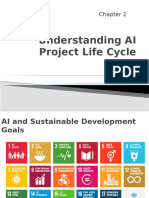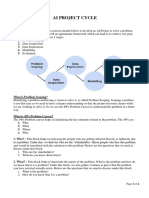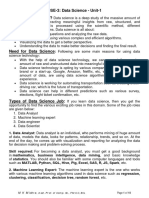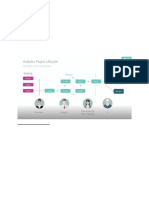Project Cycle
Uploaded by
Neha MakhijaProject Cycle
Uploaded by
Neha MakhijaINDIAN SCHOOL AL WADI AL KABIR
Class: X Department: Computer Science Date:14-05-2023
Worksheet No: 3
ARTIFICIAL INTELLIGENCE
CHAPTER 3: AI PROJECT CYCLE
One (01) Mark Questions
1. Name all the stages of an AI Project cycle.
Problem Scoping, Data Acquisition, Data Exploration, Modeling, Evaluation
2. Name the 4Ws of problem canvases under the problem scoping stage of the AI
Project Cycle.
a. Who, b. what c. where d. why
3. What is Testing Dataset?
The dataset provided to the model ML. algorithm after training the algorithm
4. Mention the types of learning approaches for AI modeling.
Supervised, unsupervised and re-enforcement
5. Which of the following is not an authentic source for data acquisition?
a. Sensors b. Surveys c. Web Scraping d. System Hacking
System Hacking
6. Which type of graphical representation suits best for continuous type of data
like monthly exam scores of a student?
Linear graph
Two (02) Mark Questions
1. What is a problem statement template and what is its significance?
The problem statement template gives a clear idea about the basic framework required
to achieve the goal. It is the 4Ws canvas which segregates; what is the problem, where
does it arise, who is affected, why is it a problem? It takes us straightto the goal.
2. Mention the precautions to be taken while acquiring data for developing an AI
Project.
It should be from an authentic source, and accurate. Look for redundant and irrelevant
data parameters that does not take part in prediction.
3. What do you mean by Data Features?
The type of data to collect, It should be relevant data.
Question Bank – AI – Class 10 – Chapter 3 AI Project Cycle
4. Write the names for missing stages in the given AI project cycle:
Problem scoping, Evaluation
5. What are the types of data?
Structured Data:
• Structured data is categorized as quantitative data.
• Structured data has predefined data types and format so that it fits well in the
column/fields of database or spreadsheet.
• They are highly organised and easily analysed.
• Examples of Structured data are: Name, age, address, cricket score board, school
time table etc.
Unstructured Data:
• Unstructured data is categorized as qualitative data.
• Unstructured data is difficult to deconstruct because it has no predefined
model, meaning it cannot be organized in relational databases.
• Examples of unstructured data include text, video, audio, mobile activity,
social media activity, satellite imagery, surveillance imagery and the list
goes on.
6. Differentiate between training and testing data.
Question Bank – AI – Class 10 – Chapter 3 AI Project Cycle
7. Explain Data Exploration stage.
In this stage of project cycle, we try to interpret some useful information out of the
data we have acquired. For this purpose, we need to explore the data and try to put it
uniformly for a better understanding. This stage deals with validating or verification of
the collected data and to analyze that:
• The data is according to the specifications decided.
• The data is free from errors.
• The data is meeting our needs.
8. What is the purpose of getting AI Ready?
The world is changing with each day and we have huge data coming our way. The
purpose of getting AI ready means taking steps to collect data around relevant systems,
equipment, and procedures; and storing and curating that data in a way that makes it
easily accessible to others for use in future AI applications.
OR
The purpose of getting AI ready specifies the responsible and optimum use of huge
amount of data around us to create and implement into such systems and applications
which should make life of future generations more organized and sustainable. This
process may lead to better lives for mankind.
9. What are the different types of sources of data from where we can collect reliable
and authentic datasets? Explain in brief.
Data can be a piece of information or facts and statistics collected together for reference
or analysis. Whenever we want an AI project to be able to predict an output, we need to
train it first using data There could be many ways and sources from where we can collect
reliable and authentic datasets namely Surveys, Web scrapping, Sensors, Cameras,
Observations, Research, Investigation, API etc.
Sometimes Internet is also used to acquire data but the most important point to keep
in mind is that the data should be taken from reliable and authentic websites only. Some
reliable data sources are UN, Google scholar, Finance, CIA, Data.gov etc.
10. What do you mean by system maps?
-System maps help us to find the relationship between the elements of the problem
which we have scoped
-A system map shows the components and boundary of a system and the components
of the environment at a point in time.
-The main use of a system map is to help structure a system and communicate the
result to others.
- It helps us in strategizing the solution for achieving the goal of our project.
-help to understand complex issues with multiple factors that affect each other
Question Bank – AI – Class 10 – Chapter 3 AI Project Cycle
Four (04) Mark Questions
1. Explain the AI Project Cycle in detail.
The steps involved in AI project cycle are as given:
• The first step is Scope the Problem by which, you set the goal for your AI project by
stating the problem which you wish to solve with it. Under problem scoping, we look at
various parameters which affect the problem we wish to solve so that the picture
becomes clearer
• Next step is to acquire data which will become the base of your project as it will help
you in understanding what the parameters that are related to problem scoping.
• Next, you go for data acquisition by collecting data from various reliable and authentic
sources. Since the data you collect would be in large quantities, you can try to give it a
visual image of different types of representations like graphs, databases, flow charts,
maps, etc. This makes it easier for you to interpret the patterns in which your acquired
data follows.
• After exploring the patterns, you can decide upon the type of model you would build to
achieve the goal. For this, you can research online and select various models which give
a suitable output.
• You can test the selected models and figure out which is the most efficient one.
• The most efficient model is now the base of your AI project and you can develop your
algorithm around it.
• Once the modelling is complete, you now need to test your model on some newly
fetched data. The results will help you in evaluating your model and hence improving it.
Finally, after evaluation, the project cycle is now complete and what you get is your AI
project.
2. Draw the 4Ws problem canvas and explain each one of them briefly.
The 4Ws problem canvas is the basic template while scoping a problem and using this
canvas, the picture becomes clearer while we are working to solve it.
a) Who: The “Who” block helps you in analyzing the people getting affected directly or
indirectly due to it? Under this, you find out who the ‘stakeholders’ to this problem are
and what you know about them. Stakeholders are the people who face this problem and
would be benefitted with the solution.
b) What: Under the “What” block, you need to look into what you have on hand. At this
stage, you need to determine the nature of the problem. What is the problem and how
do you know that it is a problem?
c) Where: In this block, you need to focus on the context/situation/location of the
problem. It will help you look into the situation in which the problem arises, thecontext
of it, and the locations where it is prominent.
d) Why: in the “Why” canvas, think about the benefits which the stakeholders would get
from the solution and how would it benefit them as well as the society.
3. What is the need of an AI Project Cycle? Explain.
Project cycle is the process of planning, organizing, coordinating, and finally developing
a project effectively throughout its phases, from planning through execution then
completion and review to achieve pre-defined objectives.
Our mind makes up plans for every task which we have to accomplish which is why
Question Bank – AI – Class 10 – Chapter 3 AI Project Cycle
things become clearer in our mind. Similarly, if we have to develop an AI project, the AI
Project Cycle provides us with an appropriate framework which can lead us towards the
goal.
The major role of AI Project Cycle is to distribute the development of AI project in
various stages so that the development becomes easier, clearly understandable and the
steps / stages should become more specific to efficiently get the best possible output. It
mainly has 5 ordered stages which distribute the entire development in specific and
clear steps: These are Problem Scoping, Data Acquisition, Data Exploration, Modelling
and Evaluation.
4. Do ethics in AI hamper data acquisition stage? Justify your answer.
Data acquisition is the most important factor or stage as the entire project development
is based on the acquired data. There are several ethical issues which must always be
considered when planning any type of data collection.
We need to understand that the data which is collected is ethical only if the provider
agrees to provide. For example, in case of smartphone users, data is collected byclicking
on allow when it asks for permission and by agreeing to all the terms and conditions.
But at the same time if one does not want to share his/her data with anyone then this
ethical issue hampers the acquisition process and lowers the accuracy or amount of
data required for development.
Hence Regardless of the type of data collection, it is absolutely necessary to gain the
approval of the community from which the data will collected otherwise.
5. What are the points to be noted on data acquisition?
• Sometimes, we use the internet and try to acquire data for your project from some
random websites.
• Such data might not be authentic as its accuracy cannot be proved.
• Due to this, it becomes necessary to find a reliable source of data from where some
authentic information can be taken.
• At the same time, we should keep in mind that the data which we collect is open-
sourced and not someone’s property.
• Extracting private data can be an offence. One of the most reliable and authentic
sources of information, are the open-sourced websites hosted by the government.
• These government portals have general information collected in suitable format
which can be downloaded and used wisely.
• Some of the open-sourced Govt. portals are: data.gov.in, india.gov.
• Some other sources: Kaggle Datasets, Amazon Datasets (Registry of Open Data on
AWS), Yahoo WebScope.
Question Bank – AI – Class 10 – Chapter 3 AI Project Cycle
You might also like
- SAP S/4HANA Cloud Sales Content With SAP Analytics Cloud ID: 3N0No ratings yetSAP S/4HANA Cloud Sales Content With SAP Analytics Cloud ID: 3N07 pages
- Resource_20240829074951_Class9-unit-1-ai_Reflection,_Ai_Project_Cycle_And_Ai_Ethics-notes_(1) (2)No ratings yetResource_20240829074951_Class9-unit-1-ai_Reflection,_Ai_Project_Cycle_And_Ai_Ethics-notes_(1) (2)5 pages
- B03 AI Project Cycle - 04 Mark QuestionsNo ratings yetB03 AI Project Cycle - 04 Mark Questions6 pages
- B03 AI Project Cycle - 02 Mark QuestionsNo ratings yetB03 AI Project Cycle - 02 Mark Questions4 pages
- SC1- Light Shadows and Reflection Class 6 Extra Questions and AnswersNo ratings yetSC1- Light Shadows and Reflection Class 6 Extra Questions and Answers4 pages
- IP Class 12 Library Management Project 2024-25No ratings yetIP Class 12 Library Management Project 2024-2540 pages
- For Queries Please Contact:::: All Fields Marked With Are Mandatory Manage Stamp SalesNo ratings yetFor Queries Please Contact:::: All Fields Marked With Are Mandatory Manage Stamp Sales4 pages
- DIGITAL-AND-TECHNOLOGICAL-SOLUTIONS-SYLLABUS-OPTION-2No ratings yetDIGITAL-AND-TECHNOLOGICAL-SOLUTIONS-SYLLABUS-OPTION-23 pages
- Department of Computer Science: Compare and Contrast The Common Scheduling Algorithms)No ratings yetDepartment of Computer Science: Compare and Contrast The Common Scheduling Algorithms)4 pages
- Com - Dual.space - Parallel.apps - Multiaccounts.appscloner LogcatNo ratings yetCom - Dual.space - Parallel.apps - Multiaccounts.appscloner Logcat9 pages
- Step 1: Requirements Clarifications: System Design Interviews: A Step by Step GuideNo ratings yetStep 1: Requirements Clarifications: System Design Interviews: A Step by Step Guide4 pages
- 28-Computer Basic Questions With Answers PDF Notes for All ExamsNo ratings yet28-Computer Basic Questions With Answers PDF Notes for All Exams43 pages
- Registration Form - : Water & Power Development Authority (WAPDA)No ratings yetRegistration Form - : Water & Power Development Authority (WAPDA)2 pages
- SAP S/4HANA Cloud Sales Content With SAP Analytics Cloud ID: 3N0SAP S/4HANA Cloud Sales Content With SAP Analytics Cloud ID: 3N0
- Resource_20240829074951_Class9-unit-1-ai_Reflection,_Ai_Project_Cycle_And_Ai_Ethics-notes_(1) (2)Resource_20240829074951_Class9-unit-1-ai_Reflection,_Ai_Project_Cycle_And_Ai_Ethics-notes_(1) (2)
- The Roadmap to AI Mastery: A Guide to Building and Scaling ProjectsFrom EverandThe Roadmap to AI Mastery: A Guide to Building and Scaling Projects
- "Big Data Science" Basic Concepts and ApplicationsFrom Everand"Big Data Science" Basic Concepts and Applications
- SC1- Light Shadows and Reflection Class 6 Extra Questions and AnswersSC1- Light Shadows and Reflection Class 6 Extra Questions and Answers
- For Queries Please Contact:::: All Fields Marked With Are Mandatory Manage Stamp SalesFor Queries Please Contact:::: All Fields Marked With Are Mandatory Manage Stamp Sales
- DIGITAL-AND-TECHNOLOGICAL-SOLUTIONS-SYLLABUS-OPTION-2DIGITAL-AND-TECHNOLOGICAL-SOLUTIONS-SYLLABUS-OPTION-2
- Department of Computer Science: Compare and Contrast The Common Scheduling Algorithms)Department of Computer Science: Compare and Contrast The Common Scheduling Algorithms)
- Com - Dual.space - Parallel.apps - Multiaccounts.appscloner LogcatCom - Dual.space - Parallel.apps - Multiaccounts.appscloner Logcat
- Step 1: Requirements Clarifications: System Design Interviews: A Step by Step GuideStep 1: Requirements Clarifications: System Design Interviews: A Step by Step Guide
- 28-Computer Basic Questions With Answers PDF Notes for All Exams28-Computer Basic Questions With Answers PDF Notes for All Exams
- Registration Form - : Water & Power Development Authority (WAPDA)Registration Form - : Water & Power Development Authority (WAPDA)




















































































































